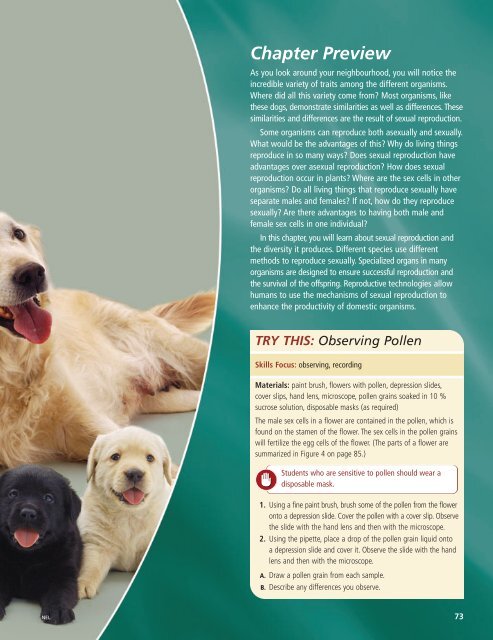Unit A Reproduction
Unit A Reproduction
Unit A Reproduction
Create successful ePaper yourself
Turn your PDF publications into a flip-book with our unique Google optimized e-Paper software.
Chapter Preview<br />
As you look around your neighbourhood, you will notice the<br />
incredible variety of traits among the different organisms.<br />
Where did all this variety come from? Most organisms, like<br />
these dogs, demonstrate similarities as well as differences. These<br />
similarities and differences are the result of sexual reproduction.<br />
Some organisms can reproduce both asexually and sexually.<br />
What would be the advantages of this? Why do living things<br />
reproduce in so many ways? Does sexual reproduction have<br />
advantages over asexual reproduction? How does sexual<br />
reproduction occur in plants? Where are the sex cells in other<br />
organisms? Do all living things that reproduce sexually have<br />
separate males and females? If not, how do they reproduce<br />
sexually? Are there advantages to having both male and<br />
female sex cells in one individual?<br />
In this chapter, you will learn about sexual reproduction and<br />
the diversity it produces. Different species use different<br />
methods to reproduce sexually. Specialized organs in many<br />
organisms are designed to ensure successful reproduction and<br />
the survival of the offspring. Reproductive technologies allow<br />
humans to use the mechanisms of sexual reproduction to<br />
enhance the productivity of domestic organisms.<br />
TRY THIS: Observing Pollen<br />
Skills Focus: observing, recording<br />
Materials: paint brush, flowers with pollen, depression slides,<br />
cover slips, hand lens, microscope, pollen grains soaked in 10 %<br />
sucrose solution, disposable masks (as required)<br />
The male sex cells in a flower are contained in the pollen, which is<br />
found on the stamen of the flower. The sex cells in the pollen grains<br />
will fertilize the egg cells of the flower. (The parts of a flower are<br />
summarized in Figure 4 on page 85.)<br />
Students who are sensitive to pollen should wear a<br />
disposable mask.<br />
1. Using a fine paint brush, brush some of the pollen from the flower<br />
onto a depression slide. Cover the pollen with a cover slip. Observe<br />
the slide with the hand lens and then with the microscope.<br />
2. Using the pipette, place a drop of the pollen grain liquid onto<br />
a depression slide and cover it. Observe the slide with the hand<br />
lens and then with the microscope.<br />
A. Draw a pollen grain from each sample.<br />
B. Describe any differences you observe.<br />
NEL<br />
73

















